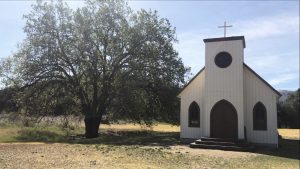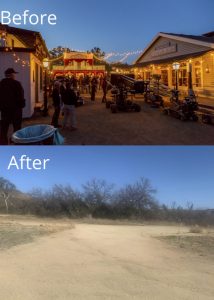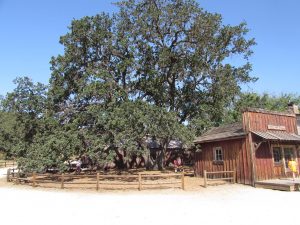
Paramount Ranch rallies after 2018 wildfire
THOUSAND OAKS, Calif. — On Nov. 9, 2018, the sky in this northern suburb of Los Angeles was filled with rising plumes of orange smoke, and the dry Santa Ana winds delivered a familiar smell of wildfires.
The Woolsey Fire had started near the Santa Susana Field Laboratory in Simi Valley on the border between Los Angeles and Ventura counties and burned through the 101 Freeway, the San Fernando Valley, and the Conejo Valley. The Santa Monica Mountains National Recreation Area (SMMNRA) was heavily damaged.
“The Woolsey Fire burned more acres within SMMNRA than any other fire in recorded history,” stated the recreation area’s official website.
 |
The chapel, built specifically for the HBO series “Westworld,” was one of only two structures that remained intact when the Woolsey Fire destroyed most of Paramount Ranch (Photo by Brianna Oard). |
According to the the National Park Service, the destructive wildfire devastated almost 100,000 acres of the Santa Monica Mountains, of which more than 21,000 of the 23,595 NPS acres (88 percent) within the park boundary burned. The destroyed land included the popular Western Town at Paramount Ranch, the set of “American Sniper” (2014), “Caught in the Draft” (1941), “Hotel de Paree” (1959-60), and most notably the iconic TV series “Dr. Quinn” (1992-98). Only the church built specifically for the HBO series “Westworld” and the train station survived.
Situated just south of the 101 Freeway in Agoura Hills in the SMMNRA, Paramount Ranch stands out for its rich history with the entertainment industry. The 2,700-acre plot of land was purchased in 1927 by the movie studio of the same name for use as a “movie ranch.”
Western Town was built in the 1950s by Entrepreneur William Hertz, which cemented the site’s status as a landmark in movie lore. Despite many ownership changes over the years, many Western films and TV series were filmed at the site. In 1980, the NPS purchased a portion of the original Paramount property and restored the sets.
“This place is really special because it’s the only site in the entire national parks service that is dedicated to interpreting American film history. It’s been a special place for film history since 1927. This is a working movie ranch, and it allows the public [into] the filmmaking process,” said Ana Beatriz Cholo, the public affairs officer of SMMNRA.
Mike Malone, a retired NPS Ranger who worked at SMMNRA from November 1996 to January 2013, echoes Cholo’s opinions on what makes Paramount Ranch special. Malone is a life-long cinephile who has witnessed various films and TV series shoots at Paramount Ranch.
“It’s about getting that rare peek to see how they create some of the illusions that you don’t always see [behind the scenes] … The illusions of filmmaking are a real rare experience for the average person outside of that [entertainment] world to actually witness,” said Malone.
Despite Paramount Ranch being located approximately 12 miles from my home in the nearby suburb of Thousand Oaks, my visit this past Saturday marked the first time that I ever went to the historic site in the SMMNRA. As I crossed the bridge connecting Medea Creek and Western Town, the charred remnants of the Woolsey Fire were still visible among the new vegetation.
In addition to the majority of Western World getting completely burned during the Woolsey Fire, the “Witness Tree,” a 70-foot-tall Valley Oak that was cut down in a February 2020 farewell ceremony, is noticeably absent. The “Witness Tree,” according to Cholo, was approximately 140 years old and not only appeared in the background of hundreds of movies and TV Shows, but also “witnessed” many weddings, special events, family photos, and other memorable occasions. Cholo also stated that debris cleanup efforts at Paramount Ranch did not commence until the middle of 2020, almost two years after the fire.
Malone recalls his first visit to the site just a few days after the Woolsey Fires destroyed the area where he worked as an NPS Ranger for almost two decades. He compared the scene of walking around the remains of Western World to walking through a cemetery.
“The experience of walking in there for the first time was something that I couldn’t predict … I just started walking around the remains that were still fresh ash, there were small curls of smoke,” Malone said.
Although the Woolsey Fire ravaged this iconic site almost two and a half years ago, the fire didn’t take away the spirit of Paramount Ranch. Visitors can still feel the cultural significance and rich history surrounding the site while exploring its trails, whether on foot or by horseback riding.
Laura Toston is the owner of Malibu Riders, which offers guided trails through Paramount Ranch, Zuma Canyon, and Malibu State Creek Park. She finds that the historic value surrounding the former is the factor that drives tourists to keep coming back, even after the devastating Woolsey Fire.
“I think it might be the history behind all the movies that have been filmed there, and just the surrounding mountains are beautiful — the area is beautiful. And if you just want to get out and do a little walk, it’s not really steep. It’s not a hard terrain for the average person,” Toston stated.
Hiking up the Hacienda Trail and Medicine Woman Trails on a warm Saturday morning, visitors can admire not just the view but also how the wildlife is slowly growing back. As I took in the sights of the landscape and surrounding hills, I noticed tall, yellow flowers along the path. For me, these flowers represent a sign of hope and that Paramount Ranch will still retain its charm as it goes through its rebuilding phase.
Cholo, the Public Affairs Officer of the SMMNRA, revealed that the national park has been in the pre-planning phase of rebuilding Paramount Ranch and Western Town for the past year. The design for reconstruction is set to be completed by the end of 2021 and construction will take place between 2022-23.
SMMNRA is also working with the Santa Monica Mountains Fund (SAMO Fund), a nonprofit organization that also serves as the park’s official fundraising partner, to raise an additional $2 million to help SMMNRA complete its restoration project.
The SAMO Fund’s fundraising efforts include holding drive-in movie theater events, of which the next one will take place on April 24. According to Charlotte Parry, executive director of the SAMO Fund, a concert is also planned for October. Despite the Woolsey Fire destroying most of Paramount Ranch and Western World, Parry believes that the area’s natural beauty is an aspect that will draw people back.
“Paramount Ranch is set in a valley surrounded by mountains and hills. It’s a magical spot with a creek running through the middle. Unlike in many places in the SMMNRA, the trails here are gentle so it’s a great place for families to enjoy the outdoors, see wildlife and wildflowers,” stated Parry.
If You Go:
- Paramount Ranch Address: 2903 Cornell Road, Agoura Hills, CA, 91301.
- Parking: The main parking area is open from 8 a.m. – sunset.
- Telephone : 805-370-2301.
- Horse Rentals: Please visit http://maliburiders.com.
- Trail Map: https://www.nps.gov/samo/planyourvisit/upload/Paramount_Ranch_fin.pdf.
- Dogs: Dogs are allowed at Paramount Ranch, but they must remain on a leash, not to exceed six feet, at all times. Please pick up after your dog.
- Pandemic: Masks must be worn at all times and covering your mouth due to the ongoing COVID-19 Pandemic.
- Supplies: Be prepared by taking water, food, flashlight, map, and first-aid supplies. Be on the alert for ticks, bees, rattlesnakes, and poison oak.
- Web: Please visit https://www.nps.gov/samo/index.htm for updated information for SMMMRA park closures and more information on current conditions due to the Woolsey Fire and the ongoing COVID-19 Pandemic.



Comments are Closed